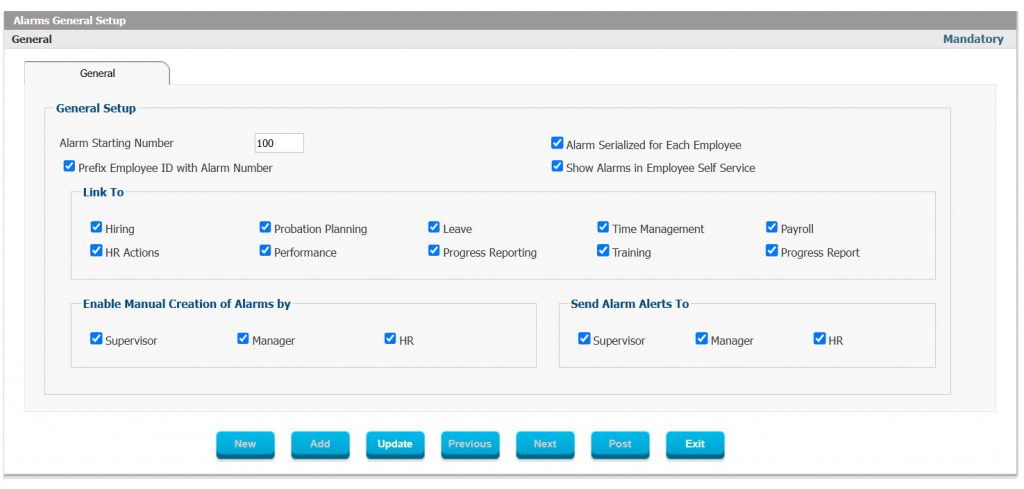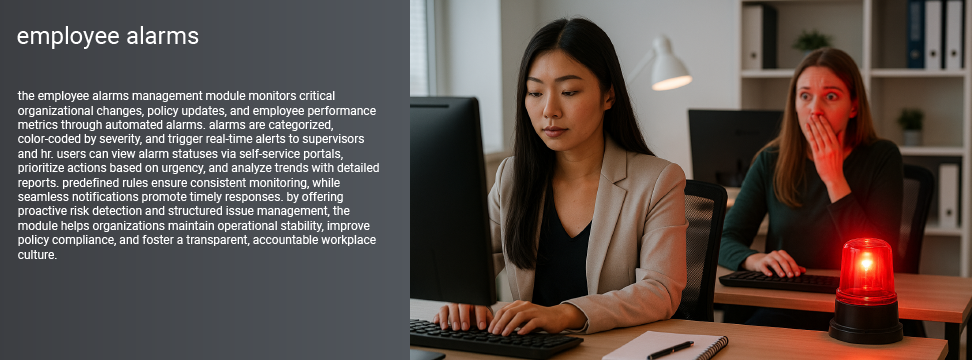Interact HRMS Employee Alarms Management Module Overview
 Figure 1: Alarm General Setup
Figure 1: Alarm General Setup
The Interact HRMS Employee Alarms Management module provides a powerful tool for monitoring and managing key events and changes within an organization that may impact operational efficiency, policy compliance, or employee performance. This module enables organizations to define a set of predefined alarms based on specific rules, ensuring that any significant changes or incidents trigger alerts for relevant stakeholders. Employee alarms fall into three primary categories, covering organizational changes, policy updates, and employee performance metrics, creating a comprehensive framework for risk detection and proactive management.
With its automated alert system and color-coded alarm statuses, the Employee Alarms Management module ensures that supervisors, managers, and HR teams are promptly notified of potential issues, allowing them to respond effectively. The module’s intuitive interface makes it easy to track alarms, review details, and prioritize actions based on alarm severity. By providing real-time visibility into critical areas, the module supports a proactive approach to organizational and employee management, helping prevent issues before they escalate.
Three Categories of Alarms for Comprehensive Monitoring
Figure 2: Alarm Policy Setup
The Employee Alarms Management module organizes alarms into three distinct categories, each addressing a different aspect of organizational operations and employee management. This categorization allows organizations to focus on specific areas that require attention, ensuring a holistic approach to monitoring and responding to critical changes.
- Foundation Setup Alarms: These alarms are triggered by changes to the foundational setup of the organization, such as modifications in the organization structure, job classifications, or employee groups. Since these elements are integral to the HRMS system’s functionality, any alterations can impact the behavior of the system and influence workflows. For example, adding a new department, modifying job classifications, or restructuring employee groups may trigger alarms to notify HR of potential downstream effects.
- Policy-Related Alarms: Policy-related alarms are triggered by updates to payroll and compensation policies, leave policies, and other operational policies. Changes in these policies can affect payroll calculations, leave entitlements, and other HR processes. For example, if a payroll policy is modified, the system will generate an alarm to ensure that the relevant stakeholders are aware of the change and its potential impact on system outcomes.
- Employee Performance and Task Alarms: This category covers alarms related to individual employee performance, progress reports, task assignments, timesheets, leave, incidents, and assessments (such as end-of-probation evaluations). These alarms ensure that HR and managers are alerted to any issues or milestones associated with employee performance, allowing them to address concerns proactively. For instance, if an employee’s progress report indicates performance issues or if there are discrepancies in their timesheets, an alarm will be generated to notify their supervisor.
By categorizing alarms in this way, the module provides a structured and organized approach to monitoring critical aspects of organizational and employee management. Each alarm type addresses a different risk area, ensuring comprehensive coverage and allowing stakeholders to respond appropriately.
Figure 3: Alarm Status
Real-Time Alarm Status Display for Quick Identification
The Employee Alarms Management module provides real-time visibility into alarm statuses, enabling HR and managers to quickly identify and address potential issues. The alarm status for each employee is displayed prominently in the system, allowing users to see at a glance whether any alarms have been triggered. If no alarms are present, the Alarm Status will show as OK (green), indicating that everything is functioning as expected. However, if an alarm is triggered, the status will change, displaying the name of the alarm and its severity level.
Each alarm status is clickable, allowing users to view detailed information about the alarm, including the underlying cause, the specific change or incident that triggered it, and any recommended actions. This level of detail enables stakeholders to understand the context of each alarm and take targeted action, promoting efficient and informed decision-making.
Automated Alerts and Notifications for Timely Responses
When an alarm is triggered, the module sends an automated email alert to relevant stakeholders, such as the employee’s supervisor, manager, and/or HR, depending on the configuration of the workflow settings. This notification system ensures that all necessary parties are informed of the issue in a timely manner, allowing for prompt investigation and resolution. The automated alerts reduce the risk of missed or delayed responses, ensuring that issues are addressed quickly to minimize potential impacts.
For example, if a policy-related alarm is triggered due to a change in leave policies, the HR team and relevant managers will receive an email notification, prompting them to review the change and ensure that it aligns with organizational requirements. By automating alerts, the module supports a proactive approach to issue management, enabling teams to address risks as soon as they arise.
Color-Coded Alarm Severity Levels for Prioritized Action
The module uses a color-coded system to indicate the severity level of each alarm, allowing stakeholders to prioritize responses based on urgency. The three levels of alarm severity are as follows:
- Normal (Green): Indicates no alarms, with the employee’s status shown as OK. This color signals that no immediate action is needed.
- Attention (Yellow): Represents a few alarms that require attention but are not critical. This color suggests that the situation should be monitored and addressed to prevent potential escalation.
- Critical (Red): Indicates a large number of alarms or a critical issue that requires immediate attention. This color signals that urgent action is needed to address the issue and prevent potential negative impacts on the organization.
By using color-coded severity levels, the module provides a clear visual indicator of each alarm’s urgency, helping HR and managers prioritize their actions accordingly. This prioritization ensures that critical alarms are addressed first, minimizing the risk of delays and promoting efficient issue resolution.
Predefined Alarm Rules for Consistent Monitoring
The Employee Alarms Management module allows organizations to define specific rules for each type of alarm, creating a standardized approach to monitoring and alert generation. These rules determine which events or changes will trigger alarms, as well as the severity level associated with each alarm type. By establishing predefined rules, the module ensures that alarms are generated consistently, based on objective criteria.
For instance, an organization may set a rule to trigger a policy-related alarm whenever a payroll policy is modified, as this could impact payroll calculations and require review. Similarly, a rule could be established to generate an employee performance alarm if an end-of-probation assessment indicates that an employee has not met performance expectations. These predefined rules ensure that the system monitors critical events and changes in a consistent and reliable manner, supporting transparency and accountability.
Self-Service Access for Employees and Supervisors
The module provides self-service access for both employees and supervisors, allowing them to view and manage alarm statuses directly through the HRMS portal. Employees can check their alarm status to understand any issues or areas that require attention, while supervisors can view alarms for their direct reports. This self-service functionality empowers users to stay informed about their performance and responsibilities, promoting transparency and encouraging proactive management.
By providing self-service access to alarm information, the module reduces the need for manual communication and follow-up, enabling employees and supervisors to take ownership of their responsibilities. This self-service approach supports an open and accountable workplace culture, where all stakeholders are engaged in monitoring and addressing potential issues.
Detailed Alarm Reports for In-Depth Analysis
The module includes robust reporting capabilities that allow HR teams to analyze alarm data and identify trends over time. HR can generate reports on the frequency of specific alarms, the most common alarm types, and the departments or employee groups that trigger alarms most often. These insights provide valuable information on areas of potential risk, enabling HR teams to address recurring issues and implement preventive measures.
For example, if reports indicate a high frequency of policy-related alarms in a specific department, HR may decide to conduct additional training on policy compliance. Similarly, frequent alarms related to employee performance could signal the need for improved performance management practices. By analyzing alarm data, HR can make data-driven decisions that enhance organizational efficiency and reduce risks.
Summary: Interact HRMS Employee Alarms Management
The Interact HRMS Employee Alarms Management module provides organizations with a structured approach to monitoring and managing critical events and changes that may impact operations, policy compliance, and employee performance. Key benefits include:
- Comprehensive Alarm Categories: Monitor foundational setup changes, policy updates, and employee performance metrics.
- Real-Time Alarm Status Display: View alarm status for each employee, with detailed information on triggered alarms.
- Automated Alerts and Notifications: Send email alerts to relevant stakeholders for timely responses to alarms.
- Color-Coded Alarm Severity Levels: Prioritize actions based on color-coded indicators for Normal (Green), Attention (Yellow), and Critical (Red) alarms.
- Predefined Alarm Rules: Establish specific rules for consistent monitoring and alert generation across the organization.
- Self-Service Access for Employees and Supervisors: Empower employees and supervisors to view and manage alarm statuses independently.
- Detailed Alarm Reports: Generate reports to analyze trends, identify recurring issues, and make data-driven improvements.
By combining these features, the Employee Alarms Management module enables organizations to detect and respond to critical events and changes proactively. This structured approach to alarm management enhances operational stability, supports policy compliance, and promotes a culture of accountability, where potential risks are addressed before they escalate.



